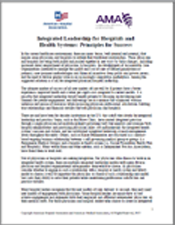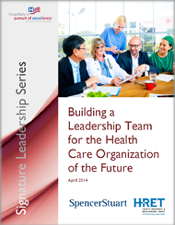Courting Physician Engagement to Improve Outcomes
 Physician engagement is an enigma for many health systems. Executives rated physician engagement as both their best opportunity to improve health system performancei and their biggest obstacle to achieving organizational objectivesii, in two separate studies. Engagement is enigmatic for physicians, too. They recognize that patient care and reimbursement models are changing, but often don’t know how they need to change their practices, let alone how much or how fast.
Physician engagement is an enigma for many health systems. Executives rated physician engagement as both their best opportunity to improve health system performancei and their biggest obstacle to achieving organizational objectivesii, in two separate studies. Engagement is enigmatic for physicians, too. They recognize that patient care and reimbursement models are changing, but often don’t know how they need to change their practices, let alone how much or how fast.
Solving these enigmas is essential for hospitals to make the quality and clinical improvement demanded by the emerging environment. Hospitals can’t do it without physician buy-in, and physicians can’t do it without institutional support.
“The question becomes: ‘How do we collaborate in this new world?’ We don’t have a system that is built that way,” says Mo Kasti, CEO of the Physician Leadership Institute, which provides leadership development services. “Physicians were trained to be knowledge leaders and to give orders. Now knowledge is ubiquitous. The physician’s role is becoming that of knowledge coordinator. That is a difficult transition for physicians.”
Some of the tactics being used to foster collaboration to improve clinical outcomes include making more use of interdisciplinary teams, including dyads, triads and other collaborative care structures; changing how physician management groups are organized and governed; promoting skills training and leadership development; updating hiring practices; introducing new technology solutions to help share information; and more. There are plenty of effective tools to encourage physician engagement, but also significant obstacles — such as knowing where to start, how to sustain efforts and how to account for fundamental time constraints.
Momentum for Change
In 2015, nearly 90 percent of hospital and health system executives wanted to engage physicians in cost and clinical improvement efforts, according to the Advisory Board Company’s Annual Health Care CEO Survey. Twice as many executives cited “physician engagement” as their best opportunity to improve cost and quality, compared to the second-rated strategy, “redesigning services for population health”.
“We are moving to a time where we can’t have separation between the administrative and clinical functions of health care,” says Dr. John Combes, the AHA’s chief medical officer and senior vice president. He also heads the Physician Leadership Forum, which offers resources for improving collaboration and physician leadership development. “The business model is not separate from the clinical model.”
Improving physician engagement can have a beneficial effect on performance, according to results from a Gallup study. It found that engaged physicians do not necessarily work more hours than their non-engaged peers, but they:
- Are 26 percent more productive
- Produce an average of $460,000 more patient revenue per year
- Provide 3 percent more outpatient referrals and 51 percent more inpatient referrals
The Gallup study didn’t examine the relationship between physician engagement and clinical outcomes, but other studies have shown a positive correlation. Still other studies have found positive links between physician engagement, retention and patient satisfaction.
There is also momentum for change on the physician side of the equation. When the Studer Groupiii asked physicians if they could change one thing about their role, the top three responses were:
- A better ability to have an impact on the changes that are occurring
- A greater sense of operational decisions
- Be permitted to lead, be permitted to eliminate minutia and needless use of my time, be permitted to practice medicine and spend time with and thinking about my patients
Improving engagement would help physicians meet all three of these top objectives.
“There is a shared responsibility between hospitals and physicians on quality and safety issues. Sometimes physicians are not educated enough on the ‘why’ they are being asked to do certain things for quality reporting and regulatory compliance,” said Dr. Zahid Butt, CEO of Medisolv. The company provides solutions that simplify quality data reporting and analysis. “Hospitals have to focus on helping physicians understand quality reporting, and give them measures that are relevant to their practices.”
Persistent Obstacles
There is growing consensus on the need to change and growing desire to do so, yet executing the changes needed to improve physician engagement and provide more collaborative care is proving to be very difficult. Many reasons have been offered, including inexperience on both the administrative and physician sides, lack of proper governance, time constraints, management structures, union contracts, interpersonal skills gaps and more. However, two obstacles consistently stand out: culture and commitment.
 Commitment was at the top of the list of 11 challenges to successfully creating new hospital leadership structures identified in Integrated Leadership for Hospitals and Health Systems: Principles for Success, a 2015 report jointly produced by the American Hospital Association and the American Medical Association. The report is intended to serve as a guide for adjusting health care leadership to better support the Triple Aim. It recommended creating an integrated physician-hospital leadership structure, identified the principles of such structures and listed 11 major obstacles
Commitment was at the top of the list of 11 challenges to successfully creating new hospital leadership structures identified in Integrated Leadership for Hospitals and Health Systems: Principles for Success, a 2015 report jointly produced by the American Hospital Association and the American Medical Association. The report is intended to serve as a guide for adjusting health care leadership to better support the Triple Aim. It recommended creating an integrated physician-hospital leadership structure, identified the principles of such structures and listed 11 major obstacles
to success.
“The changes we need to make are very doable, but we have to give them time. It takes more than inviting people to a meeting and calling it engagement,” says Kasti. “The process is messy. It’s like we’re trying to live in our house while we’re
remodeling it.”
Put another way, get married to the idea of being engaged with physicians. It is a long-term commitment that requires renewed investment of time and resources throughout.
“One-off projects don’t appeal to physicians,” says Combes. “It needs to be presented as a cultural change, not just another project the physician has to do.”
Overcoming the Obstacles
As head of the Physician Leadership Forum, Combes works with many organizations that are actively changing their approaches to care and management. He observes that “Successful hospitals are beginning to understand that their clinical staff is probably their most important asset. They are realizing that they must invest resources not only to help clinical staff do their jobs, but also must help them lead transformation across the system.”
That suggests there should be a strong commitment to professional development, which the AHA-AMA report also called for. It states:
It is important for a successful integrated health system to have physician leaders with training or demonstrated competency in leadership and management skills and an environment that supports their success.
The report goes on to list nine skills that should be nurtured. Another way hospitals can smooth the transition to new care models is by increasing the emphasis on people skills during the hiring process (see the previous Insights newsletter for additional HR strategy perspective). That represents quite a change for organizations where hiring models may favor surgeons who can bring knowledge of new techniques or other physicians with outstanding
outcome rates.
“The great organizations, and those that are working towards becoming great, are making the hard decision that technical skills are one thing, but people skills and leadership skills are important too,” says Kasti. “Hospitals should be doing more assessment of behavioral issues other than technical competency.”
 More examples of how hospitals are improving care by changing their approaches are presented in Building a Leadership Team for the Health Care Organization of the Future, a 2014 report from Hospitals in Pursuit of Excellence (HPOE). The report explores different management structures for both physician groups and hospitals, up to the board level. Its recommendations include experimenting with different organizational approaches for different disciplines, being flexible about structures and making change management a core competency. The report notes that 60 percent of health care leadership teams had become larger over the preceding three years, and that physicians and nurses were being put into leadership roles more often. That is a sign that some organizations are already on their way to solving the engagement enigma.
More examples of how hospitals are improving care by changing their approaches are presented in Building a Leadership Team for the Health Care Organization of the Future, a 2014 report from Hospitals in Pursuit of Excellence (HPOE). The report explores different management structures for both physician groups and hospitals, up to the board level. Its recommendations include experimenting with different organizational approaches for different disciplines, being flexible about structures and making change management a core competency. The report notes that 60 percent of health care leadership teams had become larger over the preceding three years, and that physicians and nurses were being put into leadership roles more often. That is a sign that some organizations are already on their way to solving the engagement enigma.
“The transformation we’re going through is past due. We were too happy with the system we had,” says Kasti. “Like any other industry, we have to continually transform and reinvent. I think we have enough talented and smart people in health care that we will come out of this transformation much better than we are now.”
i. Advisory Board Company Annual Health Care CEO Survey released March 2, 2015.
ii. Health Research & Educational Trust. (2014, April). Building a leadership team for the health care organization of the future. Chicago, Ill.: Health Research & Educational Trust. Accessed at www.hpoe.org
iii. Studer Group Releases Results of Physician Burnout Survey released February 3, 2016. Accessed February 12, 2016 at https://www.studergroup.com/resources/news-media/healthcare-tips-and-articles/studer-group-releases-results-of-physician-burnout.
